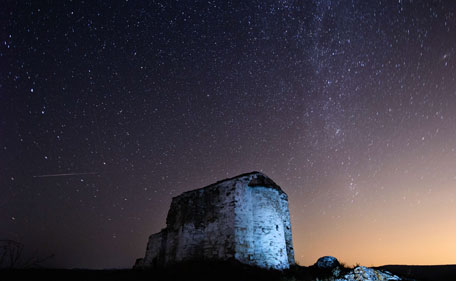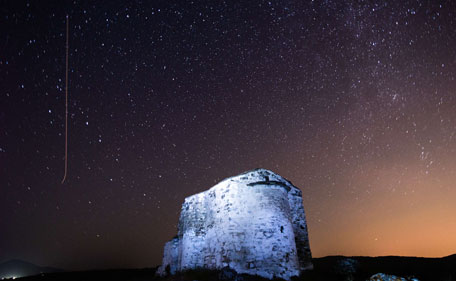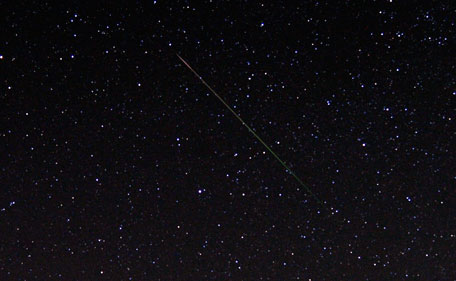- City Fajr Shuruq Duhr Asr Magrib Isha
- Dubai 05:17 06:34 12:07 15:10 17:34 18:50

In this long exposure photo, a streak appears in the sky during the annual Perseid meteor shower above a roadside silhouette of a Spanish fighting bull, conceived decades ago in Spain as highway billboards, in Villarejo de Salvanes, central Spain in the early hours of Monday Aug. 12, 2013. (AP)
In a few hours from now, the annual Perseid showerwill draw to an end for most of the world.

View of Stonehenge during the annual Perseid meteor shower in the night sky in Salisbury Plain, southern England August 13, 2013. (Reuters)
For the last two days - August 12-13 astronomers, star-gazers and even the ordinary punter in search of some heavenly drama had one eye on the sky as the Perseid shower peaked - Nasa sighting pre-dawn hours of August 12 as the best for viewing.

Perseids meteor (L) streaking across the night sky over St. Ioan medieval church near the village of Potsurnentsi, late on August 12, 2013. (AFP)
Rates can get as high as 100 per hour, with many fireballs visible in the night sky. Early in the evening, a waxing crescent moon will interfere slightly with this year's show, but it will have set by the time of the best viewing, just before dawn.

(AFP)
How to see Perseid Meteors
Nasa advises that for optimal viewing, find an open sky because Perseid meteors come across the sky from all directions. Lie on the ground and look straight up into the dark sky. Again, it is important to be far away from artificial lights. Your eyes can take up to 30 minutes to adjust to the darkness, so allow plenty of time for your eyes to dark-adapt.

A Perseid meteor (R) streaks across the sky on August 12, 2013 in Cathedral Gorge State Park, Nevada. (AFP)
About the Perseids
The Perseids have been observed for at least 2,000 years and are associated with the comet Swift-Tuttle, which orbits the sun once every 133 years.

(AFP)
Each year in August, the Earth passes through a cloud of the comet's debris. These bits of ice and dust -- most over 1,000 years old -- burn up in the Earth's atmosphere to create one of the best meteor showers of the year.
The Perseids can be seen all over the sky, but the best viewing opportunities will be across the northern hemisphere. Those with sharp eyes will see that the meteors radiate from the direction of the constellation Perseus.

(Reuters)
Earlier report:
It is being billed as most magical nights of all – one when the universe puts on a fireworks show unlike any seen.
On August 12 and 13, the Perseid Fireballs will be seen streaking across the sky.
 (Reuters)
(Reuters)
"We have found that one meteor shower produces more fireballs than any other," Bill Cooke of NASA's Meteoroid Environment Office, was quoted as saying on the science.nasa.gov website.
"It's the Perseid meteor shower, which peaks on August 12th and 13th," he adds.
Perseid Fireballs (splash)
Using a network of meteor cameras distributed across the southern USA, Cooke's team has been tracking fireball activity since 2008, and the data points to the Perseids as the 'fireball champion' of annual meteor showers.
The Nasa website explains that a fireball is a very bright meteor, at least as bright as the planets Jupiter or Venus. They can be seen on any given night as random meteoroids strike Earth's upper atmosphere.
One fireball every few hours is not unusual. Fireballs become more numerous, however, when Earth is passing through the debris stream of a comet. That’s what will happen on August 12 and 13.
The Perseid meteor shower comes from Comet Swift-Tuttle.
![]() Follow Emirates 24|7 on Google News.
Follow Emirates 24|7 on Google News.